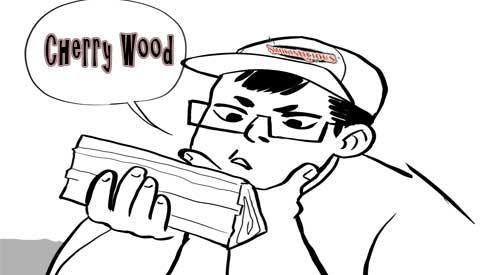Thu 20 Jun 2019
Wild Cherry Wood Question
Posted by DonnaGRead other related stories: General Smoking Information , Wood Questions
No Comments

Wild cherry Wood smoking traits discussed!
Wild cherry Wood smoking traits discussed! Share on X
What can I tell people about smoking food with wild cherry wood when they have been told there is arsenic in wild cherry wood? They want to know if it is safe. Also, what about the issue of cyanogenic compounds? Is this a concern, and if so, I assume it is a non-issue if the wood is aged a period of time?
Thank you for educating me about the SAFETY of using wild cherry wood for smoking food.
Elizabeth Andress
Elizabeth L. Andress, Ph.D.
Professor and Extension Food Safety Specialist
Department of Foods and Nutrition
The University of Georgia
Our Response to The Wild Cherry Wood Question:
Good Afternoon, Dr. Andress!
Thank you for the question regarding Wild Cherry wood! and for seeking our opinion regarding the use of the wood for smoking foods. Let’s see what new information I can present to you that may be of value.
First- What is Wild Cherry Wood?
First, it is important to note that Smokinlicious® Wood Products only manufacturers “cooking” wood from forest trees. We do not, and will not, produce our products from orchard-based woods. Our reason is simple – we do not believe in smoking foods over woods that have been or have the potential to be sprayed or growth enhanced with chemicals. As you’ve already indicated, trees produce prussic acid, better known as hydrogen cyanide. We feel that humans can use woods produced in nature when they have been left alone, unburdened by the human hand in trying to manage what sometimes is the normal cyclical pattern of nature.
In the areas in which we purchase the heartwood for our wood production facility, the varieties of cherry (Prunus pensylvanica L.f.) we commonly deal with are: Northern Pin Cherry, Fire Cherry, Wild Red Cherry, and Pigeon Cherry. Of course, predominately, we bring in Wild Red Cherry. Your portion of the country generally is known for the production of Southern Crab Apple, Narrow-Leaf Crab, Wild Crab, and Eastern Chokecherry. The main difference in these woods is that our forest trees tend to be on the sweeter side versus the sour. For the most part, hydrogen cyanide is found mainly in the leaves and seeds of the cherry tree. Black Cherry bark is also commonly used in herbal cough remedies.
Predominate Opinion- Wild Cherry Wood
The predominate opinion is that when used in small quantities, the hydrogen cyanide is a mute issue. Now let’s talk about the smoking application of wood. Cyanogenic compounds WOULD remain a factor in our production of cooking wood. This is due to the fact that we do not allow our woods to deplete their moisture content to a level that other wood product manufacturers may do (what is commonly referred to as “seasoning of the wood”).
For ideal smoking of foods, wood needs to have a moisture level preferably at 20% or higher. This results in the wood smoldering rather than burning at a rapid rate. The resulting smoke from the plant material provides for that wonderful flavor. Because smoking is done at low temperatures for longer periods of time, the polycyclic aromatic hydrocarbons (PAH’s) found in wood molecules are not stimulated as they normally would be when cooking, say, a steak over a hot flame. Thus, the health risk associated with PAH’s and smoked foods is not considered an issue.
Concerns
Our main concerns regarding woods used for cooking and smoking foods is to always ensure a bark-free product. Bark does not hold moisture but rather is designed to rid the tree of wastes by absorbing them and locking them into this area. In fact, this is the reason why bark-on woods burn so much faster than bark-free wood pieces. This portion of the tree is actually responsible for temperature flare-ups, tainted smells, “spotty” appearance of the food’s skin, an increase in the production of ash. Additionally, once the temperature is increased during wood-fired cooking, heterocyclic amines, or HCAs, are created due to the reaction of the amino acids and creatine with the higher cooking temperature.
In a nutshell, a person is at greater risk of cyanide exposure in treated wood products for home construction than they are when consuming BBQ. Knowing the source of the wood being used in the cooking application is vital to ensure that the necessary steps have been taken to prevent tree disease and pest infestation spread, as well as to ensure that the wood has not been exposed to any chemical/toxin treatments.
Our Position on the Wild Cherry Wood Question:
It is our hope, that one day soon, inspection of the wood products used by restaurants, caterers, bbq competitors, and grocery stores who promote smoked and natural-wood fired foods, will occur as normally as food inspections. After all, I think we all can agree that what you cook the food over is as an important as what food you are cooking!
Thanks again for your interest!

Dr Smoke- We receive many ? on wild cherry wood, so we offer some research!
SmokinLicious® Products related to this blog topic:
Smoker Logs
Wood Chunks: Double and Single Filet
Wood Chips: Grande Sapore®, Minuto®, & Piccolo®

More Related reading on smoker More Related reading on this subject-
See our follow up blogs related to using cherry wood when smoking, cooking, and grilling.
Where We Harvest Our Woods
WILL CHERRY SWEETEN BBQ?
PUT A CHERRY IN YOUR SMOKER